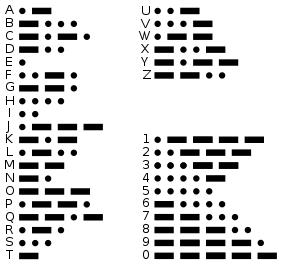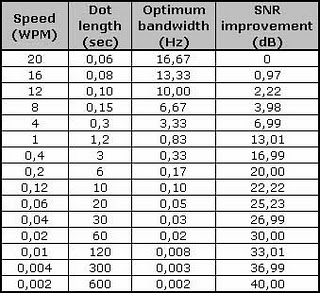In the previous post we described how effective is the reduction of the Morse code speed on the SNR and how much we can reduce our transmitting power if we reduce our code speed. Most of you may think: "Why we need to lower the code speed to extreme numbers (like many seconds per dot) since we can use some Watts and communicate in normal speeds?" Even that this question can be answered on many different ways, there are some cases where the transmission on extremely low speeds is the only option. One of them is the case were we need to transmit on ELF, SLF, ULF, VLF or LF bands where wavelength ranges from 100000km to 1km. In any of these bands the wavelength is so long that is impossible to construct a normal transmission antenna with length at least one quarter of the wavelength. In all cases the transmitting antenna will be very short compared to the wavelength and because of that its impedance will be many KOhms compared to the 50 Ohms of the transmitter output. In these cases we need special antenna tuners with huge tunable coils (variometers) that will match the impedance of our antenna with the impedance of the transmitter. The final result is a lot of power consumption on the antenna tuner and only a small part of the transmission power is radiated on the air (Effective Radiated Power or ERP). A typical example in amateur radio is the band of 136 KHz (LF) were we need at least 600 Watts of transmission power in order to produce only 1 Watt ERP! As we go lower in frequencies the radiated power becomes much lower and finally the ERP is the factor that defines what will be our Morse code transmission speed. Aside from the case that very low speed is mandatory, there are cases were radio amateurs experiment on high frequencies with very low code speeds just for the fun in order to play with QRPpp power levels and break MPW world records. There are several techniques (modes) for slow Morse code transmission. The most widely used from radio amateurs are QRSS, FSKCW and DFCW.
QRSS
QRSS is extreme slow speed CW, the name is derived from the Q-code QRS (reduce your speed). To take advantage of the very narrow bandwidth of the transmitted signal an appropriate filter at the receiver end is needed. Making a "software filter" using FFT (Fast Fourier transform) has some advantages over the old-fashioned hardware filters. One of the main advantages, when using it for reception of slow CW signals, is that FFT does not give you one single filter but you get a series of filters with which you can monitor a complete spectrum at once. This means that you do not have to tune exactly into the signal, something that can be very delicate at sub-Herz bandwidths. Also it is possible to monitor more than one QRSS signals at the same time. Further the long duration of the dots and dashes is unfavorable for aural monitoring. A solution to the above problem is to show the outcome of the FFT on screen rather than making it audible. The result is a graphic where one axis represents time, the other axis represents frequency and the color represents the signal strength. If the vertical axis represents time we call it a "waterfall" display while it is called a "curtain" display if the horizontal axis represents time. All this may sound complicated but it is easy to understand when you see the following example:

The picture above shows the signal of G3XDV as it was received on 15/01/05 from RU6LA on 136KHz with QRSS10 (10 second dots) on a two-way QSO that covered a distance of 2823km.
FSKCW
FSKCW means Frequency Shift Keying CW and is a variant of QRSS that instead of activate/deactivate the carrier, the carrier is always activated as long as the transmission lasts. During pauses between dots, dashes or characters the frequency is shifted downwards. Whilst the upper trace shown on the screen contains the morse information the lower trace is drawn during signal pauses. The advantage of this mode is its redundancy. If, for instance, a dash is falling into pieces caused by QRM there's still a chance to determine subsequently by checking the lower trace if the signal really had contained that dash or rather several dots.

The picture above shows the signal of WA5DJJ as it was received on 27/03/09 from WA0UWH on 10140KHz with FSKCW10 (10 second dots), the covered distance was 2176km.
DFCW
DFCW means Dual Frequency CW and is a combination of QRSS and FSKCW. In the LF band of 136KHz where the most common used mode is QRSS3, a very basic QSO will take about 30 minutes. Changing QRN levels and/or propagation during this period can have a vast effect on a QSO. Therefore the DFCW mode was developed that enhances the average speed by a factor of 2.5 to 3. In DFCW the element duration is replaced by the element frequency. So dots and dashes no longer have a different length but they are transmitted on a different frequency. Due to this frequency shift there is no space needed between the dots/dashes and the character space can be reduced to the same dot length. To make it even easier to read, especially during a sequence of dots or dashes, a short space (typically 1/3 of a dot length) is added between the dots and dashes. This reduces the average speed a bit, but is improves the readability and also reduces the transmission duty cycle. At a speed of 3 seconds per dot the CQ message will take 5'30" in QRSS while it will take only 1'54" in DFCW. The speed advantage of DFCW over QRSS can be taken in 2 ways, either by reducing the duration of a QSO or by increasing the dot length and working at a narrower bandwidth. The last means that, for the same duration of a QSO, the dot length in DFCW can be 2.5 to 3 times longer and as a result of this get a 4 to 5dB better SNR.

The picture above shows the signal of CT1DRP as it was received on 14/04/04 from OH1TN on 136KHz with DFCW120 (120 second dots), the covered distance was 3364km.
Reception of QRSS, FSKCW & DFCW
In order to receive signals of these modes you need of course an antenna and an SSB receiver for the frequency of interest. The audio output of the receiver must be connected to the soundcard of a PC and with the help of specialized software like: Argo, Spectran, SpectrumLab, QRSS VD and many others, you will able to receive and decode signals via the embedded FFT procedures.
References:
[1] Wikipedia, Radio spectrum, http://en.wikipedia.org/wiki/Radio_spectrum
[2] ON7YD, Extreme narrow bandwidth techniques, http://www.qsl.net/on7yd/136narro.htm
[3] DL6JAN, CWKtiny Instruction manual, http://www.proehl-elektronik.de/cwk/manual/manual5_e.html


